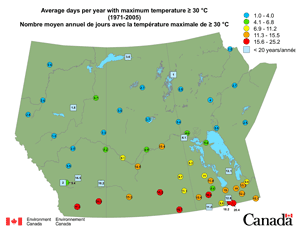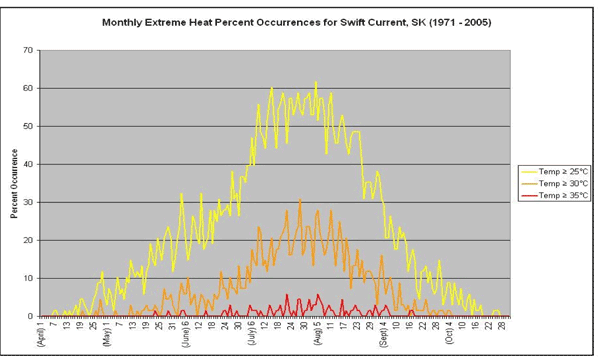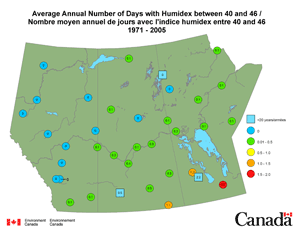Heat Waves
High temperatures are hazardous to people, the environment and crops. In Saskatchewan summer temperatures are increasing and heat waves are expected to be more frequent and severe.

Heat waves are a potential major health risk as evidenced by the 700 people killed by heat in Chicago in 1995 and the 70,000 who died in the European heat wave of 2003. Complications arise from heat exhaustion, heat stroke and aggravation of asthma symptoms. Some people are more at risk than others, including the elderly, disabled, children, low income families and the homeless.
Saskatchewan currently experiences few days over 30°C. In Figure 1, only 3 sites are shown to experience more than 15 days annually over 30°C: Estevan, Regina and Swift Current. There were significant provincial heat waves in 1936, 1988, 2002 and 2007.
To illustrate the relative range of temperature extremes experienced in southern Saskatchewan information for Swift Current is provided in Figure 2. For Swift Current between 45 and 60 percent of summer days had temperatures of over 25°C. However, less than 5% of the days had above 35°C temperatures.

This graph illustrates the percentage occurrence of temperature over a certain value for any single day based on 1971 to 2005 observations. For example on August 5th, approximately 60 percent of the days experienced a temperature of 25°C or more; 27% of the time the maximum temperature was over 30°C and 5% of the time over 35°C. (Source: Environment Canada)
When high temperatures are accompanied by high humidity the impact on human health is even more pronounced. Environment Canada has developed a humidex rating system that is an indication of how hot and humid weather feels to the average person (visit: EC website). Environment Canada will issue a humidex advisory when the humidex reaches or surpasses 40. In 2001, a humidex advisory was issued, the first time in 30 years for Saskatchewan.

Figure 3 shows the average number of days with a humidex between 30 and 40. Only one site has more than a single day occurrence – Estevan at 1.1.
Extreme heat and humidity are not currently a major problem in the province. However, as the overall temperature increases, heat waves can be expected, and if associated with high humidity and/or drought the impacts could be significant.
During the summer of 2007, Regina experienced near-record setting temperatures and humidity. The resultant high humidex was not only uncomfortable but led to hospitals postponing all but emergency surgery. By 2008 heating, ventilation and air-cooling systems had been improved so that “the (Health) Region is able to deal with extreme weather conditions”.
Adaptation Actions
Adaptation by individuals, communities and the provincial and federal governments will be required to mitigate the impact of heat waves.
- Individuals can take action to minimize the impact of heat by being aware of the signs of heat stroke and drink lots of water, maintain salt levels, keep in the shade, take breaks, and use fans, etc. Health Canada provides additional information on dealing with a heat wave (visit: HC Extreme Heat Events website)
- Governments and communities can ensure that emergency preparedness plans are in place to deal with a heat wave. Health Canada is now working on a project - Developing Heat Resilient Communities and Individuals in Canada (visit: HC website)
- Communities can also implement design and landscape initiatives to reduce the heat island effect by replacing hard surfaces with vegetative cover and planting trees.
- Building design can help to minimize internal temperatures through use of overhangs, tinted window, shades and awnings, etc.
- High summer temperatures leads to increased use of air conditioners and greater demand for electricity. Alternative cooling and energy conservation measures are adaptation options. A partial alternative to air conditioning is to use ceiling fans.
- Electrical grid systems can fail under extreme heat. SaskPower, the major utility, needs to maintain grid resilience to heat.
Sources:
- Environment Canada (n.d.): Extreme Heat - Atmospheric Hazards – Prairie and Northern Region http://pnr.hazards.ca/extreme_heat.html[accessed February 6, 2011]
- Environment Canada (n.d.): Hazardous Weather http://www.ec.gc.ca/meteo-weather/default.asp?lang=En&n=15E59C08-1 [accessed December 4, 2010]
- Environment Canada (n.d.): The Top Ten Weather Stories for 2002 – Regional Highlights. http://www.ec.gc.ca/meteo-weather/default.asp?lang=En&n=4803F5B7-1#r5 [accessed March 11, 2011]
- Environment Canada (n.d.): The Top Ten Weather Stories for 2007. http://www.ec.gc.ca/meteo-weather/default.asp?lang=En&n=5EBCEA59-1 [accessed March 11, 2011]
- Health Canada (n.d.): Climate Change and Health Adapting to the Health Effects of Climate Change http://www.hc-sc.gc.ca/ewh-semt/climat/adapt/index-eng.php [accessed December 4, 2010]
- Health Canada (n.d.): Developing Heat Resilient Communities and Individuals in Canada http://www.hc-sc.gc.ca/ewh-semt/climat/adapt/heat-chaleur-eng.php [accessed February 20, 2011]
- Health Canada (2009): The Urban Heat Island Effect: Causes, Health Impacts and Mitigation Strategies Climate Change and Health Adaptation Bulletin Number 1. http://www.hc-sc.gc.ca/ewh-semt/pubs/climat/adapt_bulletin-adapt1/index-eng.php[accessed February 7, 2011]
- Public Safety Canada (2010): Canadian Disaster Database http://www.publicsafety.gc.ca/prg/em/cdd/srch-eng.aspx [accessed February 8, 2011]
- Regina Qu’Appelle Health Region (2009): 2008/2009 Annual Report http://www.rqhealth.ca/inside/publications/history/pdf_files/rqhr_ar_2008_09.pdf [accessed March 11, 2011]
- Regina Qu’Appelle Health Region (2006): Heat, humidity tax hospitals. elink The RQHRegion Online Newsletter. http://www.rqhealth.ca/inside/publications/elink/pdf_files/elink_26july07.pdf#xml=http://www.rqhealth.ca/cgi-bin/texis.cgi/webinator/search_rhd/+Fw5zmxwww/xml.txt?query=heat&pr=rqhr&order=r&cq=&id=4d77fbb82f [accessed March 11, 2011]